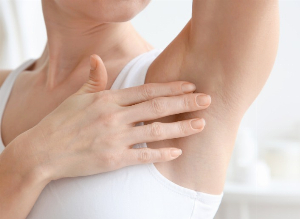All about Verneuil disease!
Published 31 Mar 2023 • By Claudia Lima
Verneuil disease is a chronic inflammatory disease of the skin. It is also called hidrosadenitis, hidrosadenitis suppurativa (HS), pilosebaceous follicle disease or Verneuil-Hutchinson disease.
This pathology, which is very poorly understood and affects 1-4% of the population in the UK.
What is Verneuil disease? What are the symptoms, causes and treatments?
Do you want answers? Read our article!

What is Verneuil disease?
Verneuil disease is a chronic and suppurating (pus-producing) inflammation of the skin. It affects the areas of the body where the sweat glands called apocrine glands are located. These glands are found in the groin folds, armpits, nipples in women, behind the ears and on the skin of the ano-perineal areas.
This very painful disease affects both men and women, with a predominance of women. It usually begins in adolescence or young adulthood.
Verneuil disease is neither contagious nor transmissible. About 1 in 3 cases of the disease might run in families, but the precise pattern of inheritance is unknown.
What are the symptoms and causes of Verneuil disease?
The symptoms of Verneuil disease can vary from person to person and also according to the unpredictable course of the disease. They appear after puberty and initially manifest as simple nodules under the skin. It is a disease that progresses in periods of flare-ups, alternating with periods of remission.
The main symptoms of Verneuil disease are painful knots (rounded, protruding skin formations) and comedones. They become abscesses (clusters of pus and blood collected in a cavity) which may burst. Fistulas (a canal from which fluid flows) may also occur. Repeated occurrence of these lesions can lead to the formation of hard patches and hypertrophic (raised) scars in the affected areas.
Symptoms may worsen if the disease is not treated. Comorbidities associated with Verneuil disease include IBD (Crohn's disease and ulcerative colitis), ankylosing spondylitis, certain skin cancers (e.g. squamous cell carcinoma) and pyoderma gangrenosum (chronic skin necrosis).
Verneuil's disease is a form of acne whose exact cause is not known. The trigger for this disease is an occlusion of the pilosebaceous follicle, which causes inflammation and then the destruction of the apocrine glands. The area becomes infected and affects the different layers of the skin (dermis and hypodermis).
Certain factors are thought to trigger Verneuil disease, such as hormonal factors (in women, during menstruation and pregnancy), bacterial infection (streptococcus, staphylococcus, etc.), obesity, smoking (active and passive) and also a genetic predisposition.
What are the treatments for Verneuil disease?
Verneuil disease is diagnosed by a clinical examination by a dermatologist, often after a long period of medical wandering, on average 8 years. It is frequently confused with other pathologies such as severe acne, actinomycosis, furunculosis and sometimes Crohn's disease, among others.
To date, there is no cure for Verneuil disease.
For proper management of the disease, the symptoms of Verneuil disease are distinguished into 3 stages (1 to 3 or mild/moderate/severe), defined by the Hurley classification of 1989. Accordingly, several methods of symptomatic or basic treatment are proposed depending on the stage of development of the disease.
Monitoring of the lifestyle
Because of the potential triggering effect of certain bad habits in Verneuil disease, it is recommended that the patients affected, consider losing weight and quitting tobacco.
Treatment of the pain
Non-steroidal anti-inflammatory drugs (NSAIDs) and corticosteroids may be prescribed for severe pain.
Treatment of nodules
In the event of a flare-up, washing with soap and water should be the first line of treatment.
Antibiotic therapy may be prescribed to try to limit the development of nodules into abscesses. This treatment is generally of short duration, and may also be provided for prophylactic purposes, in other words, to prevent the appearance, spread or aggravation of a wound.
Other drug treatments are proposed:
- Antibiotic therapies such as tetracyclines or rifampicin-clindamycin combination,
- Anti-androgen treatments,
- Retinoids,
- Zinc gluconate,
- Radiotherapy,
- Immunomodulators.
For Verneuil disease, one drug may work on one person and not another. And although they do not lead to a systematic cure, these treatments help to correct inflammation and skin damage.
Surgical treatment
The only radical treatment for Verneuil disease can be surgery. Different techniques are used:
- Excision with a suture which is done under local anesthesia, which relieves the pain temporarily and evacuates the pus. This method does not prevent recurrence.
- Externalization of abscesses and fistulas with directed open healing, using bandages.
- Wide and deep surgical excision, under general anesthesia. It allows the removal of suppurative lesions, fistulas and apocrine glands in depth, in order to avoid the risk of recurrence. Healing does not occur spontaneously and several methods of healing and covering surgical wounds are possible. It is sometimes necessary to perform a skin graft.
- Excision by CO2 laser under local anesthesia is also used in mild to moderate forms.
Psychological support
Recurrences of the disease, surgical operations and the unsightly appearance of the lesions, in addition to the pain, have a strong impact on the quality of life of Verneuil disease patients. Psychological support can be necessary, depending on the case. It is important to have a relative or a medical specialist to talk about it.
There are associations for Verneuil patients in the UK such as The British Medical Association (BMA), The British Skin Foundation and The PCDS (Primary Care Dermatology Society).
Verneuil disease is a chronic inflammatory disease that can be managed with appropriate treatments. Diagnosis and treatment are often difficult, but there are options to help patients manage pain and other symptoms.
Studies are being conducted to analyse the quality of life of patients with Verneuil disease and to better understand and find better treatment options for this disease. This includes the development of more effective drug treatments, improved surgical procedures and better diagnostic methods.
Did you find this article helpful?
Click Like and share your thoughts and questions with the community in the comments below!
Take care of yourself!
Comments
You will also like

Adalimumab (Humira®, Amgevita®, Imraldi®, Idacio®, Hyrimoz® and Yuflyma®): everything there is to know!
26 Jan 2023

 Facebook
Facebook Twitter
Twitter

